Camino de Santiago - French Way - Stage 10 - Santo Domingo de la Calzada to Belorado
Total distance: 22.9 km
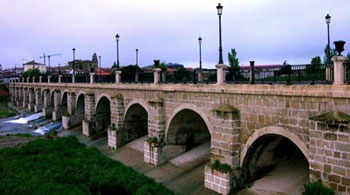
Leave Santo Domingo de la Calzada by following the way markers, metal arrows embedded in the road, passing the cathedral and turning left onto the Calle Mayor and then right onto the main road, Calle de los Palmajeros which soon becomes Avenida de la Rioja. The road leads you across the 148 metre long Puente del Santo (Saint's Bridge), the bridge Santo Domingo built with its 16 arches. Unfortunately the original bridge is largely hidden because of various embellishments over the centuries.
Cross the bridge over the Río Oja, following mainly farm tracks you will shortly come across a T junction giving you a choice of 2 routes, one is slightly longer, approximately 3 kilometres, but it does avoid the main road or you could take the slightly shorter route of approximately 2 kilometres. Whichever route you choose you will come to the town of Grañon.
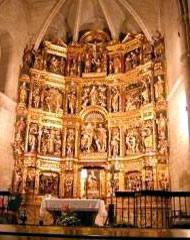
Dating back to the 9th century the town boasted a castle built by King Alfonso III to defend against Muslim invasion. The castle soon fell into ruins but the town prospered because of the Camino and at one time had two monasteries, a pilgrim hospice as well as fortifications. Unfortunately no traces of the walls remain and the only remaining building of note is the restored 16th century Iglesia de San Juan Bautista, built over the site of one of the old monasteries. Inside you will find a fine example of a Baroque alter piece or Retablo.
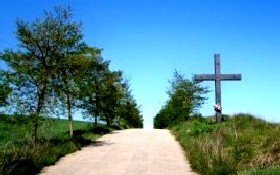
On your way from Santo Domingo to Grañón you most likely passed a simple cross called la Cruz de los Valientes. In the 14th century the towns of Grañón and Santo Domingo were in dispute over a piece of land situated between the two towns. There didn't appear to be any solution to the issue of who owned the land and the situation very nearly ended in all out war. Rather than letting the situation deteriorate even further, the elders of the two towns met to discuss the problem and the solution they came up with was a rather unusual one – a bare knuckle fight.
The towns had to choose two men, one from each side who would fight for their respective towns. The man who won the fight would win the land for his town. Grañon chose a common labourer called Martín García as their champion, but Santo Domingo cheated a little and chose a professional fighter. They put their prize fighter on a “power” diet and on the day of the fight covered him in olive oil so that his opponent couldn't get a grip on him. Despite all their shenanigans and following a long and bitter fight, it was Martín García, not the professional fighter, who came out victorious.
Returning to the Camino, in Grañón there is an albergue called Hospital de Peregrinos which can be found next to the Iglesia de San Juan Bautista.
Head out of the village following the markings, don't worry if you feel like you are going back on yourself, the route will eventually turn left past a modern barn and onto a minor road. Follow this road and after about 200m you will come to a barn with a yellow arrow painted on it. Take this route over a bridge across the Rio Relachigo, taking a left where you come upon a huge sign indicating the border between La Rioja and Castilla y Leon. Continue down a farm road and after approximately 3 kilometres you reach the village of Redicilla del Camino.
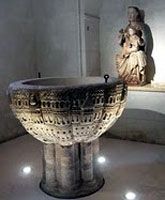
Redicillo del Camino is a small, one street village that has owed its existence to the Camino since the 11th century. The village has a long history of caring for pilgrims and once had 3 pilgrim hospitals and as many as 11 hermitages. Here you will find the Iglesia de Nuestra Señora de la Calle, which contains a beautiful 12th century Romanesque baptismal font which is well worth stopping to see.
The albergue, Hospital de San Lázar, is built on the site of one of the original medieval pilgrim hospitals and is situated opposite the church.
Leaving Redicillo del Camino past the church and public garden along the Calle Mayor, cross the main road (N120) and then take the gravel track until you arrive at Castildelgado.
Castildelgado once had a monastery and pilgrims hospital, but nothing really remains of either of these buildings. There is a sorry looking church, Iglesia de San Pedro, but little else other than a bar/restaurant, bakery and a hostal.
Leaving the village take the track that runs parallel with the main road and after about 1 kilometre take a left turn onto a smaller road which leads to Viloria de la Rioja, the birthplace of Santo Domingo.
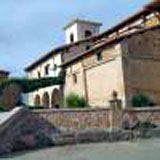
Unfortunately, the house in which he was born has recently been demolished but the font in which he was baptised can be seen in the Iglesia Viloria de la Rioja.
The Camino de Santiago did not originally pass this way but was redirected in the 11th Century by Sancho III to pass through Belorado.
For those wishing to stay the night there is a small albergue which sleeps about 12 people.
Head out of the village along a quiet country road and then down a track which runs alongside the main road. After approximately 4 kilometres you come to a small village with delusions of grandeur.
Villamayor del Rio, or roughly translated, large town of the river, is in fact a small village by a little stream. There is not much to Villamayor del Río, but there is an albergue for those wishing to stay. There is also a restaurant on the main road, but be warned, despite being on the Camino they discourage backpacks and walking sticks. So if you choose to go in you will be asked to leave your backpacks and sticks outside.
Continue through the village on the track that runs parallel to the main road and you will soon come across a picnic area, cross the road and follow the track into Belorado.
Lying in the valley of the Río Tirón in the shadow of the mountain, this town can trace its origins to Roman times. It once had a castle, which now lies in ruins but from which you get fabulous views of the valley. By the 13th century the town was home to 8 churches, none of which have survived. However, there are two churches, the 16th century Iglesia de Santa María and the 18th Century Iglesia de San Pedro. The Iglesia de San Pedro contains some impressive altars some of which depict Santiago Matamoros and the pilgrim or peregrino.
The Monasterio de Santa María de la Bretonera which was re-established in the 14th century can be found on the outskirts of the town, as can the Convento Santa Clara.
The Camino, once deviated from its original route, played a part in the town's development. In medieval times the town had a thriving Jewish community, like so many other towns. The area now known as Barrio Nuevo was once the Jewish ghetto. The Jews were expelled by the Catholic Monarchs, Ferdinand and Isabela in the 14th century, which caused the ruin of the local economy. Unfortunately, the area hasn't fared so well in modern times either with the gradual demise of the leather industry.
In its favour Belorado does have an unusually high concentration of bars and cafés and two albergues close by. The tourism office is currently holding an exhibition on the Camino in the Centro de Promoción Jacobeo which may be worth a visit. Check before you go as 2010 was a holy year and the exhibition may have only been running during that time.

